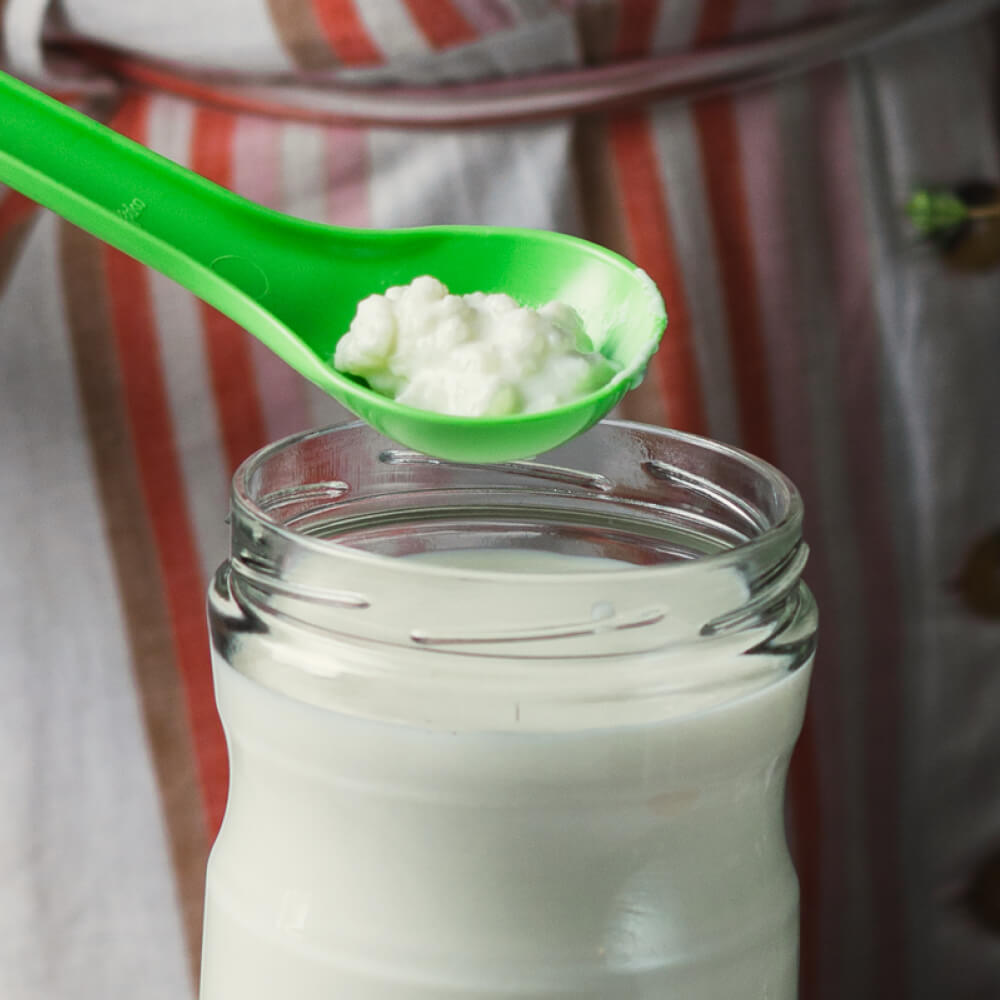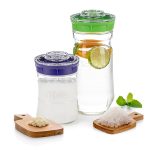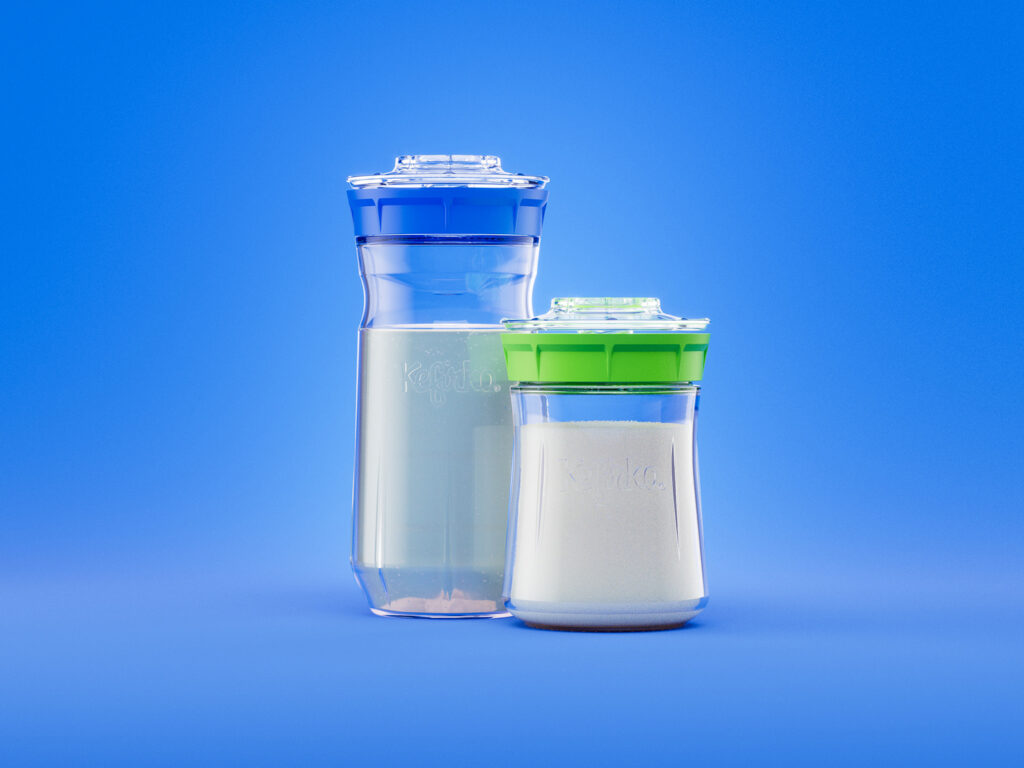KEFIR GRAINS

Kefir grains are live cultures needed to prepare milk or water kefir. We distinguish between water and milk grains which are a bit different in the structure. Live cultures are reusable. With proper care they can last for a lifetime. They also grow and multiply with every batch of kefir you make. Sooner or later you get extras that you can use for additional batches of kefir or you can share it with others.
The kefir grains consist of proteins, polysaccharides and a mixture of several types of microorganisms, such as yeasts and aroma and lactic-acid forming bacteria proven highly beneficial to humans.
See answers to FAQs about kefir grains below.
In specific case of kefir we need to introduce yeast and bacteria into the milk with help of kefir grains. Alternatively, you can culture with starter culture – lab made powder – which will introduce needed cultures in order to trigger fermentation process.
Generally speaking, powdered kefir starter has 7 to 9 strains depending on the particular brand of starter. Milk kefir grains and water kefir grains contain a long list of bacteria and yeast strains and subspecies, making kefir grains the more probiotic-rich culture for making kefir.
Kefir grains …
Fermentation with kefir grains is traditional natural process and therefore produce better results. There is also difference in how we use each. We put the kefir grains in the milk before fermentation and then simply remove them after (12 to 48 hours later). From there, we can use same grains to ferment a new batch of kefir.
… or starter culture?
We add starter Culture to milk and mix. Then we leave the mixture to ferment for desired amount of time. At the end, we can use directly the kefir. If you wish to maximize the use of one starter package, you can save small portion of kefir and use it to culture next batch. This will only work up to 4 or maybe 5 times (depending on the brand) before the live organisms get too weak.
Kefir grains for traditional fermentation
Traditionally, kefir cultures were shared among family and friends. Kefir grains are growing with every new batch and sooner or later people had abundance of cultures that they gave away. Nowadays, many companies are selling the grains since the demand exceeds supply.
Sharing is caring!
We have established a platform on Kefirhood.com where everyone can easily search and share cultures among other fermented food enthusiasts.
We produce quality ORGANIC cultures: fresh and dehydrated milk kefir grains and fresh and dehydrated water kefir grains.
Kefir grains consist of proteins, polysaccharides and a mixture of several types of microorganisms, such as yeasts and aroma and lactic-acid forming bacteria proven highly beneficial to humans.
Milk kefir or búlgaros is a result of the inoculation of milk with milk kefir grains.
Prepare milk kefir …
We use milk kefir grains to make milk kefir and water kefir grains to make water kefir. The milk kefir grains are small white blobs that look a lot like cauliflower florets.
… or water kefir!
Water kefir, also known as tibicos, is a result of the inoculation of sugary water with tibicos (water kefir grains). To make water kefir we need a bit more of water kefir grains than milk kefir grains. The grains are translucent and crystal-like in appearance.
To prepare kefir we need live kefir grains. But to allow storage and easier transport, grains are sometimes dehydrated or freeze-dried. We have to activate these grains before you can prepare kefir with them.
Dehydrated kefir grains
Dehydrated kefir grains are dried with dehydrator and being left dormant. It’s easy to store dehydrated grains in the cool space, fridge or freezer for longer periods. Dehydrated grains are also easier to transfer, ship for longer distances. To start using them again you have to follow the manufacturer instructions for re-hydration. Usually it takes a few batches until your grains are active enough to produce kefir.
Freeze-dried grains
Freeze-dried grains have the same benefits as dehydrated grains regarding storing and shipping. You need to re-activate the grains by manufacturer’s instructions before making kefir with them.
To make grains freeze-dried they go through a special procedure called lyophilization or freeze-drying that preserves biological material by removing the water, it involves first freezing then drying at a very low temperatures. Many microorganisms survive the freeze-drying well and the culture will be easily reactivated and grown after longer periods of storage.
Give away your extras!
Kefir grains are constantly growing and multiplying and it is common practice to share your extras with others. Measure the grains periodically by using the measuring cup and give your extras to other kefir fermenters.
There can be many reasons why the growth of your grains is slower or non-existent. Here are some possible reasons for that:
The fermentation is too long
If you make more consecutive longer fermentation, the grains might starve. When grains don’t get enough food for longer periods, they won’t grow.
The temperature is too low
Slower temperatures are slowing down the fermentation and the growth of grains. It’s best to leave the grains on optimal temperature and not changing it all the time, that puts stress on the grains and they will not grow.
The milk is not providing enough food for the grains
We recommend using full fat fresh organic milk to enable enough food for grains to grow. You can prepare milk kefir with raw or pasteurized milk but avoid over-pasteurized milks.
The water is damaging the grains
You should prepare water kefir with fresh, non-chlorinated and non-filtered water. The chlorine in the water can kill the bacteria strains in the grains, while filtered water lacks the minerals that kefir grains feed on. It’s ideal to use natural spring water full of minerals to encourage the growth of grains.
Get kefir grains here:
Firstly you should avoid all the things written above (why my grains are not growing). Kefir grains are a live culture and it’s ok to leave them to grow at their own pace. If you are still not satisfied with the speed your grains grow at, you can try different things.
Shake/stir the grains during fermentation so you can encourage more milk gets in contact with the grains.
Enable optimal and consistent temperature around 20-25 degrees celsius.
Milk kefir grains
Smaller grains grow faster because they have bigger areas in contact with their feed.
Use wholefat milk that ensures more food for the grains.
Adding some powder milk to increase lactose amount in milk.
Water kefir grains
Use sugared water instead fruit juice to help them multiply.
Give your grains mineral-rich environment (water, raisins or sugar can help) but prevent over-mineralization. Adding mineral supplements like concentrace can also be a way to encourage grains growth.
Get milk or water kefir grains
Milk kefir
The proper ratio between the grains and milk is important, when making milk kefir. Kefirko Kefir Maker is equipped with a measuring cup in the top lid and tactile markings on the outside of the jar. Measure the grains first: for one serving fill the measuring cup with the grains up to the first mark for one serving, or up to the top (approx. 6 g) for two servings or full Kefirko Kefir Maker.
Water kefir
The proper ratio between the grains and water is important, when making water kefir. With a full strainer lid of tibicos grains (approx 30 g) you can prepare 0.6 l of water kefir.
Water and milk kefir grains:
If you notice your grains going a bit slimy you should not be alarmed. Your kefir grains have not gone bad. This is a natural thing that occurs when making kefir. This slime is actually a complex sugar or polysaccharide, called also kefiran.
1. After washing the grains, place them in a small plastic zip bag. For 1 tsp of grains use 3 tbsp of cold water.
2. Add a pinch of sugar. Push out as much air as you can and close the bag.
3. Put bag with kefir grains in one or two more plastic bags. It’s now ready for shipping.
4. For more safety you can use mail with air bubble protection. With these techniques kefir grains will stay alive for about two weeks for sure.
Always follow the instructions from the manufacturer when you’re buying kefir grains. Usually it takes a few batches for grains to acclimatise to your environment and ingredients.
Activation of grains
When you got the grains as a gift or someone from sharing communities like Kefirhood send them to you, you should activate the grains too. Make sure to ask the person who gave you the grain for as much information regarding the fermentation of these grains in the past as you can. What kind of milk/water was used? What temperature they were fermented on? How often were they fermented? For how long were they inactive.This will help you acclimatize the grains faster. Try copying the information with your fermentation as much as you can at the beginning. If you want to make some changes (use coconut milk instead of cow etc.) do that a bit later, when grains become fully active and do it slowly not to shock the grains.
You can either prepare a new batch of kefir or store the kefir grains for a period of time. If you want to store your extra milk kefir grains, put them in a small jar and add some milk (for a shorter period – up to 7 days) or add water with a pinch of sugar (for a longer period – up to 2 months) and store the sealed jar in the refrigerator.



